Don't wanna be here? Send us removal request.
Text
Spot network systems for distribution of electric power in downtown areas of cities

The AC secondary network system is the system that has been used for many years to distribute electric power in the high-density, downtown areas of cities, usually in the form... Read more
The post Spot network systems for distribution of electric power in downtown areas of cities appeared first on EEP - Electrical Engineering Portal.
0 notes
Text
Three good examples of the application of modern relays to transformer protection
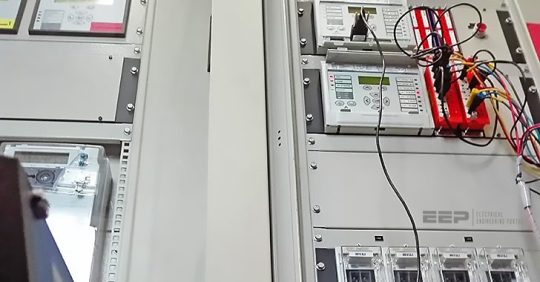
This technical article provides three examples of the application of modern relays to transformer protection. As there are many modern protection relays nowadays that provide advanced software to simplify the... Read more
The post Three good examples of the application of modern relays to transformer protection appeared first on EEP - Electrical Engineering Portal.
0 notes
Text
Friday Product Post: You've Been Thunderstruck!
Hello, there everyone! It's Friday, and that means we have some new products to show you all - starting with a Lightning Detector Breakout. Yup, you read that right! We also have the new Google Coral Single Board Computer, and three DMX cables. Let's take a closer look at all!
youtube
Storm's Coming, Ani!
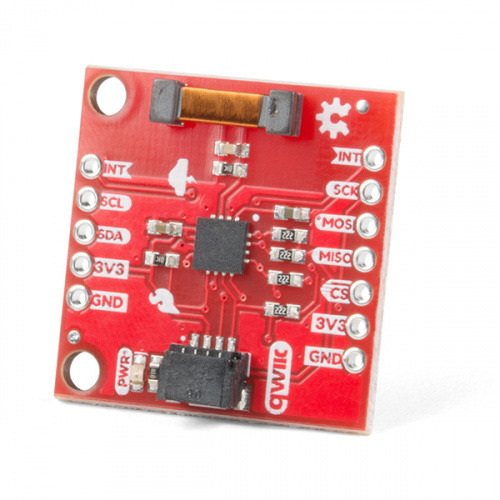
added to your cart!
SparkFun Lightning Detector - AS3935 (Qwiic)
In stock SEN-15276
The SparkFun Qwiic Lightning Detector adds lightning detection to your next weather station to make sure you are aware of any…
$24.95
Favorited Favorite 1
Wish List
Add the SparkFun Qwiic Lightning Detector to your next weather station to make sure you are aware of any potential hazardous weather heading your way. The AS3935 is capable of detecting lightning up to 40 km away, with an accuracy of 1 km to the storm front, and a sensitive antenna tuned to pick up lightning events in the 500 kHz band. Utilizing our handy Qwiic system, no soldering is required to connect it to the rest of your system. However, we still have broken out 0.1"-spaced pins in case you prefer to use a breadboard.
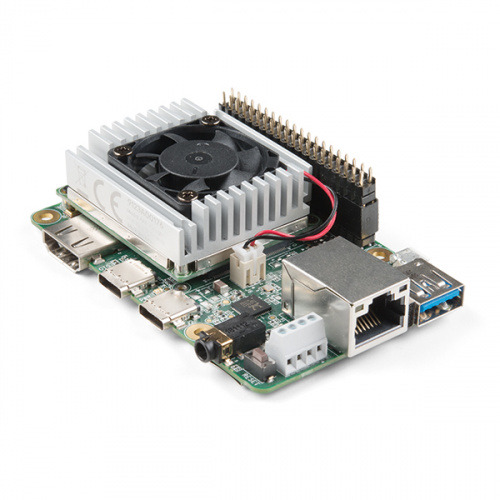
added to your cart!
Google Coral Development Board
In stock DEV-15318
Machine learning development board from Google.
$156.95
Favorited Favorite 0
Wish List
The Coral Dev Board is a single-board computer with a removable system-on-module (SOM) that contains eMMC, SOC, wireless radios and the Edge TPU. You can use the Dev Board as a single-board computer when you need accelerated ML processing in a small form factor, but it also serves as an evaluation kit for the SOM. You can use the dev board to prototype internet-of-things (IoT) devices and other embedded systems that demand fast on-device ML inferencing, and then scale to production using just the 40 mm × 48 mm SOM board combined with your custom PCB hardware using board-to-board connectors.
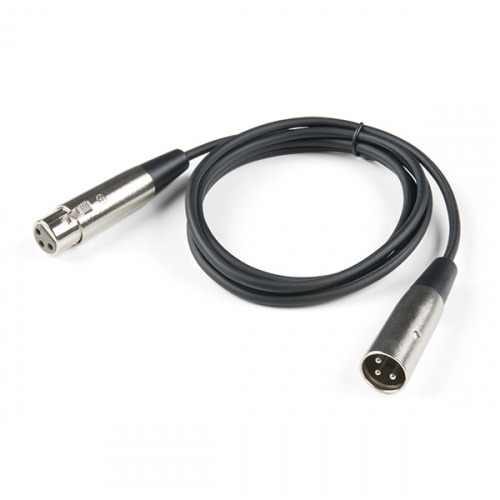
added to your cart!
XLR-3 (DMX) Cable - 5ft
In stock CAB-15308
This is a five foot long DMX cable capable of better communications for lighting and special effects through standard or digi…
$4.95
Favorited Favorite 0
Wish List
This is a five-foot-long (~1.5 m) DMX cable capable of better communications for lighting and special effects through standard or digital communication protocols. We specifically like to use this cable with our ESP32 Thing Plus DMX to LED Shield, but it can also be used to interface with other DMX fixtures, as well!
If you need a longer cable, you're in luck! We also offer cable lengths of 10 ft and 25 ft.
That's it for this week! As always, we can't wait to see what you make! Shoot us a tweet @sparkfun, or let us know on Instagram or Facebook. We’d love to see what projects you’ve made!
comments | comment feed
0 notes
Text
Enginursday: How to Develop a Package for Microsoft MakeCode
Microsoft MakeCode is a quite powerful, block-based coding language useful for anybody trying to learn how to code. However, creating packages for this language is sometimes a little difficult. I've developed quite a few of these packages in the past and figured that the somewhat unclear process could use some documentation for posterity. The below tutorial will get you developing your own MakeCode packages in no time.
New!
How to Create a MakeCode Package for Micro:Bit
April 16, 2019
Learn how to develop code blocks for the Micro:bit in Microsoft MakeCode!
Favorited Favorite 0
comments | comment feed
0 notes
Text
Antenna Connectors
With a plethora of GPS/GNSS products going live recently, I wanted to talk a bit about the various connectors you'll find. SMA and RP-SMA are some of the older antenna options. SMA stands for SubMiniature version A and was developed in the 1960s with a male connector having the pin, and the female connector having the socket. This means that the female connector is inserted into the male connector (I know, confusing).
Then along came RP-SMA or Reverse Polarity SMA. This connector type reversed the location of the pin and socket but didn't change the gender of the connectors. So, now the female RP-SMA has a pin and the piece is inserted into the male housing.
You'll still see SMA on quite a few boards and antenna, and with their 500+ mating cycles they are fairly popular for instances where you need to change your antenna. One thing to be careful of: I've seen manufactures list boards as SMA while the actual connector is RP-SMA. While technically RP-SMA can be considered a type of SMA, it is worth noting that you should be careful when buying an antenna.
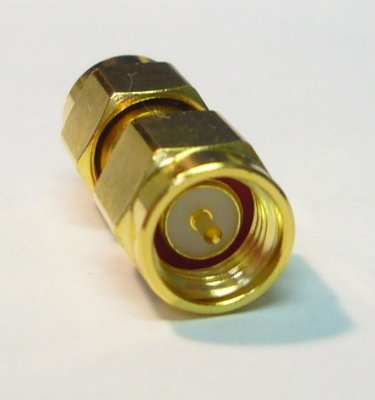

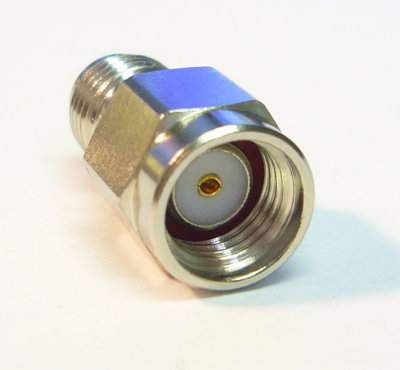
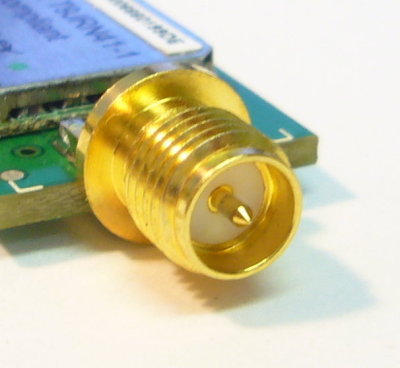
SMA Male Center Pin, Inner Threads SMA Female Center Hole, Outer Threads RP-SMA Male Center Hole, “Male” Inner Threads RP-SMA Female Center Pin, “Female” Outer Threads
The newer u.FL was created by Hirose, but because of its small and fragile size is only rated for about 30 mating cycles. While this is good for permanent connections that really only need to be changed for replacement of faulty parts, it is not so good for constantly swapping out antennas. This is one reason you will see u.FL to SMA adapters. Check out our RF Connector Buying Guide for more information on RF Connectors.
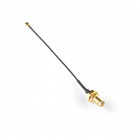
added to your cart!
Interface Cable SMA to U.FL
In stock WRL-09145
This is a 4" connector cable that interfaces U.FL RF connectors to regular SMA connectors.
$4.95
3
Favorited Favorite 10
Wish List
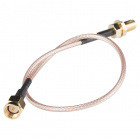
added to your cart!
Interface Cable - SMA Female to SMA Male (25cm)
Out of stock WRL-12861
This is a basic SMA (Sub-Miniature A) male to female connector cable. Each cable is 25cm (9.8") long and has a 50Ω impedance…
$4.95
1
Favorited Favorite 4
Wish List
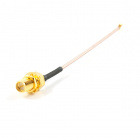
added to your cart!
Interface Cable RP-SMA to U.FL
In stock WRL-00662
This connector cable interfaces UFL RF connectors to RP-SMA antennas. Use it to attach any standard RP-SMA 2.4GHz antenna to …
$4.95
1
Favorited Favorite 8
Wish List
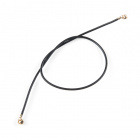
added to your cart!
U.FL to U.FL Mini Coax Cable - 200mm
In stock WRL-15114
This cute little coax is a champ in our RF kit! It has a right angle female U.FL (aka I-PEX) connector on both ends. Now inst…
$1.95
Favorited Favorite 1
Wish List
Because of the u.FL's small size and fragile connectors, we've put together some helpful tips on using u.FL to prolong the life of your board, your cables, and your antennas.
Three Quick Tips About Using U.FL
December 28, 2018
Quick tips regarding how to connect, protect, and disconnect U.FL connectors.
Favorited Favorite 3
comments | comment feed
0 notes
Text
Single line diagrams of substations 66/11 kV and 11/0.4 kV (reading & analysis)
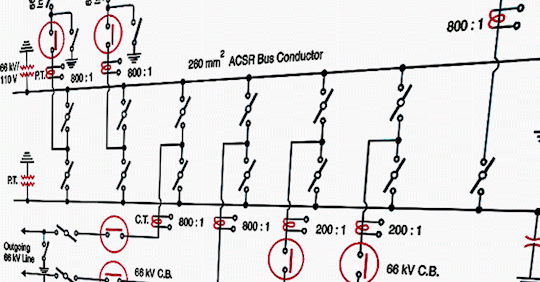
This technical article describes single line diagrams of two typical power substations 66/11 kV and 11/0.4 kV and their power flow, principles of incoming lines (incomers) and outgoing lines (feeders),... Read more
The post Single line diagrams of substations 66/11 kV and 11/0.4 kV (reading & analysis) appeared first on EEP - Electrical Engineering Portal.
0 notes
Text
Batteries? What For?
This is a guest blog post from Andrew Shepherd. Andrew has been studying electronics in earnest for over a decade and loves working with his mind and hands. He specializes in analog electronics, but his interests are eclectic and span seemingly unrelated areas.
If you need a project to be portable, here’s a small crash course on some of the batteries that are available and what situations they are good for.
Types:
There are two main types of batteries: primary and secondary – batteries that can be recharged and those that are one-use-only. Today we'll cover only the most relevant and available types for the sake of brevity, as the full catalog of battery types could fill pages. We will also only explore certain secondary batteries.
Lead-Acid - This is the oldest type of rechargeable battery. They can supply a lot of current but are also very heavy compared to newer types. They tend to be used in cars and stationary equipment, like UPSs (Uninterruptible Power Supplies), due to their durability and tolerance for low temperatures. Cell voltage is ~2.1 V each, but they typically come in 6V or 12V packs. Charging and discharging is quite simple, as long as the upper and lower voltage bounds are not grossly exceeded and the charge current is not too high. If they are abused they can outgas hydrogen and potentially explode.

added to your cart!
Lead Acid Battery - 12V 7.2Ah
In stock PRT-15066
This is a Panasonic Sealed Lead Acid Battery. It is a valve regulated rechargeable battery. These units are designed to provi…
$47.95
Favorited Favorite 0
Wish List
NiMH - These are an improvement on the NiCd batteries, and are a proven and reliable battery technology. They are more power dense than lead-acids, but have a lower cell voltage of ~1.2V under load. Recharging and discharging is also fairly simple given that you don’t draw current below a certain voltage. If abused they can overheat and lose a lot of their capacity.

added to your cart!
2500 mAh NiMH Battery - AA
In stock PRT-00335
2500mAh 1.2V Nickel Metal Hydride rechargeable 'AA' batteries. [NiMH technology](http://en.wikipedia.org/wiki/Nickel_metal_hy…
$2.95
Favorited Favorite 3
Wish List
-
LiPo/Li-Ion - The difference between LiPo and Li-Ion is subtle and the technologies are typically combined for most batteries, so they will be regarded together. These are lightweight, high power density, high cell voltage (3.7V under load). Their output current capability is consistently better than NiMH for a given size. Their disadvantage is they are less stable than other batteries and care must be taken when charging or discharging. The charging process is more complicated and requires a special process to avoid damage. For multi-cell systems, cell balancing is required for charging and discharging. If these batteries are abused, they can explode and shoot flames and fluoride gas everywhere.
Types of LiPos
These things come in all shapes and sizes and can be used for many applications due to their high power density.
Small Li-Ion Flat Packs - These are useful for small projects and most can interface directly with many SparkFun products. Paper-thin, flexible batteries also exist and may be best for wearables.

added to your cart!
Lithium Ion Battery - 850mAh
In stock PRT-13854
These are very slim, extremely light weight batteries based on Lithium Ion chemistry. Each cell outputs a nominal 3.7V at 850…
$9.95
2
Favorited Favorite 6
Wish List
<-
18650s - Shaped like a large AA battery, these are a versatile store-and-replace cell with lots of current capability and capacity. Their main advantage is they can be swapped in and out, or be bundled together into a pack.

added to your cart!
Lithium Ion Battery - 18650 Cell (2600mAh)
In stock PRT-12895
No, these aren't some sort of weird, AA battery, this is actually a 18650 Lithium Ion Cell. These round high capacity cells h…
$5.95
Favorited Favorite 11
Wish List
Multicell Packs - If you need more voltage than 3.7V this is the way to go. You’ll need a charger capable of cell balancing to use them, however.

added to your cart!
Lithium Ion Battery - 2200mAh 7.4v
In stock PRT-11856
This high discharge LiPo is a great way to power any R/C, robotic, or portable project. This is an excellent choice for anyth…
$15.95
Favorited Favorite 6
Wish List
USB LiPo Pack - These are useful for small Arduino projects because they provide USB power (5V at 1A) in a small, handy package.

added to your cart!
Lithium Ion Battery Pack - 2.5Ah (USB)
In stock PRT-14367
We've taken the classic, portable, rechargeable lithium ion battery pack and tweaked the design to make it amenable to low cu…
$8.95
Favorited Favorite 0
Wish List
LiPo Management
USB Chargers - This USB LiPoly Charger runs from either a DC jack or a micro USB connection and charges a single cell Li-Po through a common JST connector. It also has an output port so it can be used in a project without reconnecting the battery after charging. This charger lets you adjust how much current you want to charge with a basic USB charger.
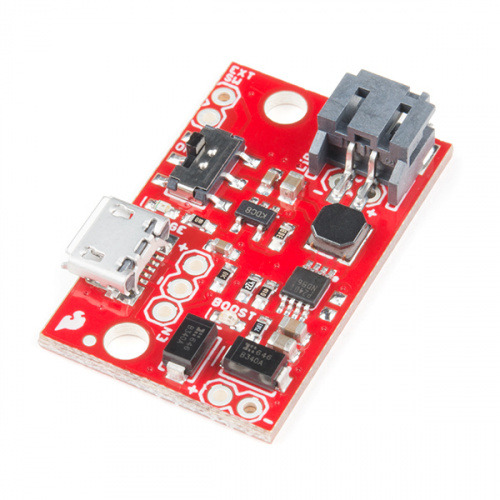
added to your cart!
SparkFun LiPo Charger/Booster - 5V/1A
In stock PRT-14411
The SparkFun 5V/1A LiPo Charger/Booster is a no-nonsense circuit for generating one amp from a Lithium Polymer battery at 5V.…
$15.95
Favorited Favorite 11
Wish List
Boost Converter - This takes a single cell 3.8V LiPo and boosts the voltage up to 5V to make it usable for most microcontroller and LED circuits. It can source up to 1A of current.
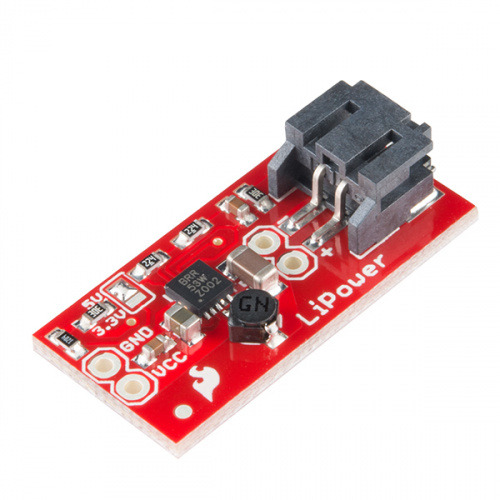
added to your cart!
LiPower - Boost Converter
In stock PRT-10255
The LiPower board is based on the incredibly versatile TPS61200 boost converter. The board is configured to be used with a Li…
$15.95
5
Favorited Favorite 21
Wish List
Multiple Cells
What if you need more voltage or current capability? The solution is to add cells in series for more voltage, and cells in parallel for increased current capability and capacity. With LiPos especially, it is critical the cells can charge and discharge correctly. You can put cells in parallel with each other, but they must be protected somehow. Otherwise, they can discharge into each other and cause damage. One way is to use a Schottky diode in series with each cell, which will allow current to pass out of each cell but prevent damage if one cell gets lower than the others.

Charging multiple cells requires cell balancing or separate chargers for each cell. The advantage of 18650s is that they can be removed and charged separately in a bay like this.

added to your cart!
Tenergy T4s Intelligent Universal Charger - 4-Bay
In stock TOL-14457
The 4-Bay T4s Intelligent Universal Charger from Tenergy is an automatic smart charger compatible with almost all types of re…
$29.95
Favorited Favorite 5
Wish List
Useful Resources and Further Learning
Dave Jones of EEVBlog explains the charging process of LiPos. It lends clues as to why the charging process is more complicated than NiMH or other batteries, and discusses how you could make a charger yourself.
This website carries a lot of different types of batteries, including special ones that might be hard to find elsewhere.
DIY battery charger using the TP4056 chip.
comments | comment feed
0 notes
Text
Learn HV substation elements (graphic symbols, basics & connection schemes)
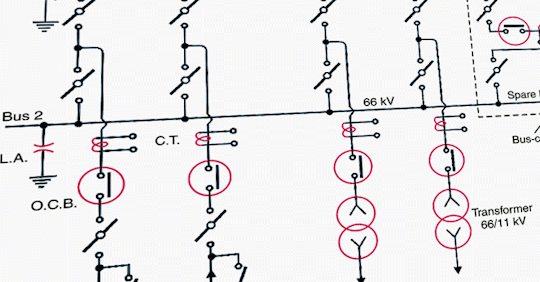
High voltage substations are pretty complex to understand since they have a way too many elements and each element is complex for itself and it depends on many system parameters... Read more
The post Learn HV substation elements (graphic symbols, basics & connection schemes) appeared first on EEP - Electrical Engineering Portal.
0 notes
Text
Learn to read and understand single line diagrams and wiring diagrams
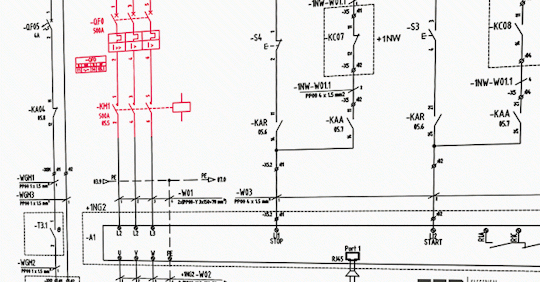
Single line diagrams are used in common engineering practice as graphical representation of electrical switchboard or assembly containing more sections, i.e. cubicles. Basically, they are simplified and digest picture of... Read more
The post Learn to read and understand single line diagrams and wiring diagrams appeared first on EEP - Electrical Engineering Portal.
0 notes
Text
Friday Product Post: Balancing the Scales
This week, to celebrate the final season of everyone's favorite romcom, Game of Thrones, we've added a bit of a theme! We have the new SparkFun Qwiic Scale to weigh all your coinage, a new TFT LCD Breakout to expand your options for watching your favorite (miniaturized) show, and our new Master of Coin shirts! That's not all though, because we end the week with a new, 12-inch ruler and two strips of APA104 LEDs to light up the darkest, terror-filled night!
youtube
Weigh it all in the blink of an eye!
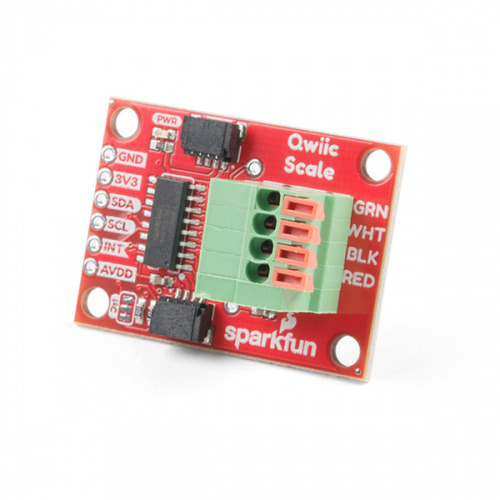
added to your cart!
SparkFun Qwiic Scale - NAU7802
In stock SEN-15242
The SparkFun Qwiic Scale - NAU7802 is a small breakout board for the NAU7802 that allows you to easily read load cells to mea…
$14.95
Favorited Favorite 2
Wish List
The SparkFun Qwiic Scale is a small breakout board for the NAU7802 that allows you to easily read load cells to accurately measure the weight of an object. By connecting the board to your microcontroller, you will be able to read the changes in the resistance of a load cell and, with some calibration, get very accurate weight measurements. This can be handy for creating your own industrial scale, process control or simple presence detection. Utilizing our handy Qwiic system, no soldering is required to connect it to the rest of your system. However, we still have broken out 0.1"-spaced pins in case you prefer to use a breadboard.
youtube
Display whatever you wish!
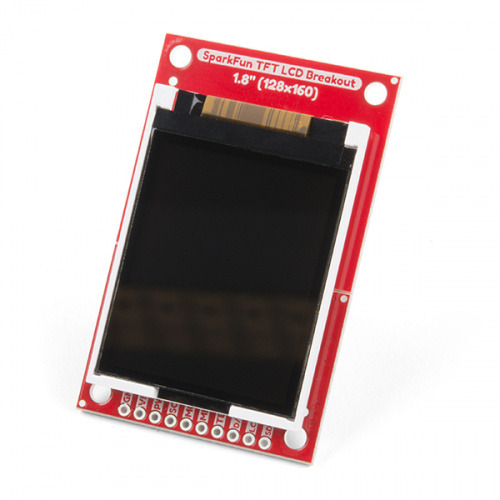
added to your cart!
SparkFun TFT LCD Breakout - 1.8" (128x160)
In stock LCD-15143
A 128x160 color (18 bit!) TFT LCD display. Use this breakout to easily add visual display/interface capabilities to a project…
$29.95
Favorited Favorite 0
Wish List
The SparkFun TFT LCD Breakout is a versatile, colorful and easy way to experiment with graphics or create a user interface for your project. With a 4-wire SPI interface and microSD card holder, you can use this breakout to easily add visual display/interface capabilities to a project, as well as provide all the storage you might need for multimedia files.
youtube

added to your cart!
Master of Coin Women's Shirt - Large (Gray)
15 available SWG-15234
This large, gray, women's shirt has been designed to keep all those around you guessing at what game you are playing with a C…
$19.95
Favorited Favorite 0
Wish List

added to your cart!
Master of Coin Shirt - Large (Gray)
17 available SWG-15239
This large, gray, men's shirt has been designed to keep all those around you guessing at what game you are playing with a CR2…
$19.95
Favorited Favorite 0
Wish List

added to your cart!
Master of Coin Shirt - Large (Red)
18 available SWG-15280
This large, red, men's shirt has been designed to keep all those around you guessing at what game you are playing with a CR20…
$19.95
Favorited Favorite 0
Wish List

added to your cart!
Master of Coin Women's Shirt - Large (Red)
15 available SWG-15285
This large, red, women's shirt has been designed to keep all those around you guessing at what game you are playing with a CR…
$19.95
Favorited Favorite 0
Wish List
Our new limited edition tee is here, with a nod to Game of Thrones! These shirts come in red and gray in both men's and women's fitted sizes, and are designed to keep those around you guessing what game you're playing with the positive side of the classic coin cell battery that we carry in our catalog. The back also has our SparkFun emblem on the negative side of the CR2032.
Even though we only show the large sizes in this blog post, please be aware that sizes S through XXL are available as well! Click here to find each size available, but remember: these shirts are only available for a limited time so get them while you can because once they are gone, they are gone!
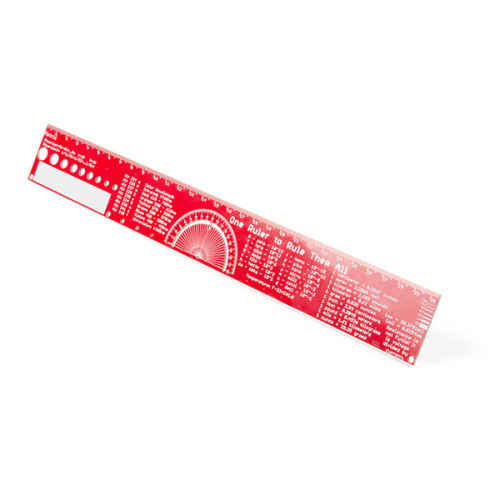
added to your cart!
SparkFun PCB Ruler - 12 Inch
In stock TOL-15295
One Ruler to Rule them All. A PCB ruler with useful conversions and information.
$5.95
Favorited Favorite 3
Wish List
One ruler to rule them all! This may look like a basic 12-inch ruler, but it's made from a PCB. We have included useful information you might use on a daily basis, including wire gauge holes, transistor diagrams, common fractions, Roman numerals and metric-to-imperial conversions. Most importantly, the ruler provides you with a straight line, centimeter markings one side and inch markings on the other side.
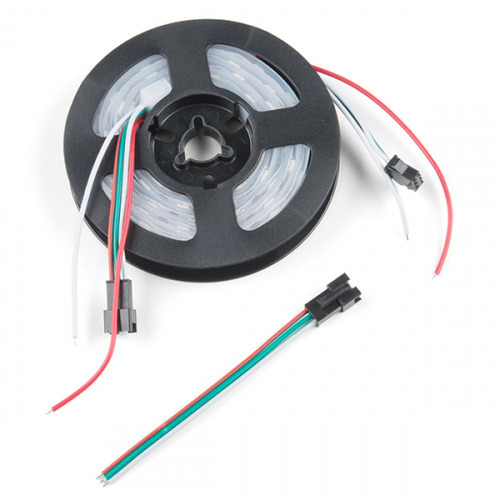
added to your cart!
LED RGB Strip - Addressable, Sealed, 1m (APA104)
In stock COM-15205
These are sealed addressable 1 meter long 5V RGB LED strips that come packed with 60 APA104s per meter.
$24.95
Favorited Favorite 0
Wish List
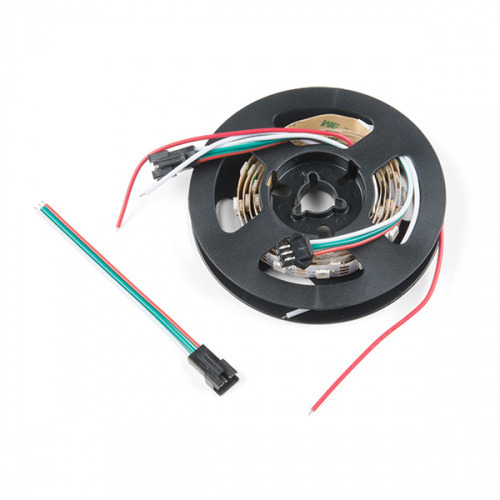
added to your cart!
LED RGB Strip - Addressable, Bare, 1m (APA104)
In stock COM-15206
These are bare addressable 1 meter long 5V RGB LED strips that come packed with 60 APA104s per meter.
$19.95
Favorited Favorite 0
Wish List
These are sealed and bare addressable, one-meter, 5V RGB LED strips that come packed with 60 APA104s per meter. There is access to each APA104 LED and each strip length can be easily modified. You will be able to control each RGB LED individually, giving you the ability to create cool lighting effects for your car, or perhaps under-cabinet lighting in your kitchen! These LED strips are compatible with similar WS2812 and SK6812 addressable LEDs.
That's it for this week! As always, we can't wait to see what you make! Shoot us a tweet @sparkfun, or let us know on Instagram or Facebook. We’d love to see what projects you’ve made!
comments | comment feed
0 notes
Text
Enginursday: A Beginner's Guide to Sourcing from Alibaba
Alibaba is the Wild West of product sourcing - a freewheeling, international bazaar offering low-cost bulk parts and products that range from the mundane to the, well, bizarre. Here, the risks are high but the potential benefits manifold. You may seek your fortune reselling low-cost goods (or finding low-cost parts for your widget), but you may find yourself flim-flammed, hoodwinked and yes, even bamboozled. But oh, the rush when your diligence pays off!
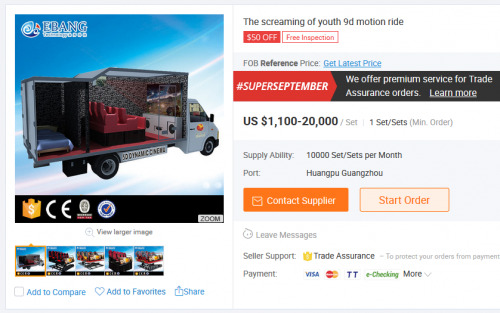

It seems excited.
I will begin with an important disclaimer: at this stage in my procurement career (and in SparkFun’s history), sourcing from Alibaba is basically the last resort. SparkFun has worked hard over the years to develop a list of trusted vendors. Many of these companies have locally-based representatives, knowledgeable sales contacts and field application engineers we can meet with face-to-face to discuss all our latest needs and quirks. Others are vendors in China, Taiwan and other countries whom we discovered via Alibaba eons ago, and have since built long-standing relationships with.
If you already have a supplier with whom you have an established, trusting relationship, love and cherish them all the days of your life. Understand also that their capabilities may extend far beyond what’s reflected in their catalog or line card. If there’s something specific you need, ask your existing contacts. At the very least, they may be able to provide you with a referral. I also highly recommend ThomasNet as an alternative starting point for finding reliable, quality sources for components, hardware, equipment, you-name-it.
That said, onto the fun. If you’re starting from scratch as we once did, or you simply like to walk on the wild side, you may be ready to plunge into the wacky world of Alibaba. Let’s begin with the search bar.

Don't look at my search history.
This part is pretty straightforward. Here, you can search for parts by keyword or toggle the little arrow to search for particular suppliers. As with any search, you’ll want to find that sweet spot between specificity and generality. It’s also important to know what that thing you’re looking for is called! That seems obvious enough, but keep in mind that there are different synonyms out there for the same type of product (e.g. “coin cell” vs. “button cell”), and businesses in other countries might have different naming conventions than you’re used to.
You can also browse items by market (at left) if you have a vague idea of the type of things you’re looking for and just want to peruse the marketplace. There’s also a new image search feature (the camera icon at the right). As it turns out, you can even search for products based on the current status of your life:
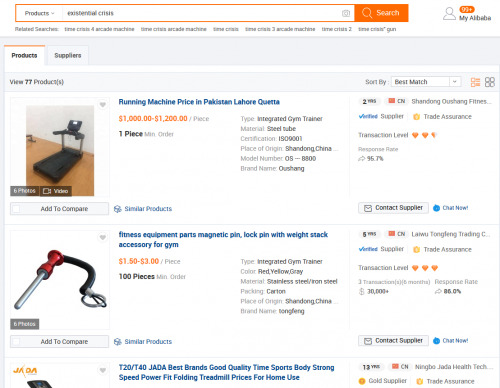
Time to hit the gym!
Once you’ve honed in on a thing you might want to buy in quantity, you’ll see on the product page a handy little pricing scale, info about shipping charges and lead time.

How many horse masks will you require today?
Great, right? Well, ignore it. IGNORE IT ALL. It could be accurate, sure, or it could be that the supplier just put random information in there because honestly-who-really-knows. If you want to know how much the thing costs, ask.
But first, try to learn a little about the supplier by clicking on the supplier name at right and perusing their company page. Alibaba is far less Mos Eisley Cantina-ish than it once was. They have a variety of verifications and certifications to help you sort out the legit from the sketchy, although there’s always some risk regardless. I like to see a high customer satisfaction rate, “Gold Supplier” status (multiple years is always a plus) and a decent rate of response.
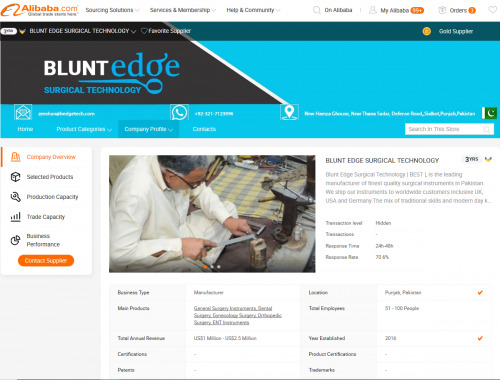
Lookin' good.
Once you’ve achieved that nice, warm, fuzzy feeling, feel free to message away. At the bottom of the page you’ll see the box you can use to send a message to the supplier. I cannot stress enough how important it is to keep this first message as simple as possible. I’ve found that I’m far less likely to get a response if I include multiple questions, customization requests, lists of products, sample inquiries, etc. I know, it’s hard to imagine that somewhere a sales rep is perusing their inbox and smashing that delete button every time a message is more than three sentences long, but there it is. Here is the basic template of what I send:
Dear Mr/Ms [rep name], Hello, this is [name] with [company name]. Please quote me for [quantity] pcs of your [product name or part number]. Thanks and kind regards, [name] [email address]
That’s it! This is not to imply that Alibaba suppliers won’t send you samples, customize their product, give you quotes for multiple pricing tiers and multiple products, discuss terms, etc. This simple first email jus gets the conversation going, and you can feel free to move on to all those subjects and more once the wheel has begun turning. Alibaba has a messenger feature, but I always include my email in the signature of the first message to emphasize that I’m okay with them emailing me directly. Personally, I prefer to communicate this way, but to each their own. If you do include your email, you will eventually get spammed, so be ready. You can also make a “business card” on Alibaba, which includes your contact information, and you can choose whether to share it or not with each message you send.
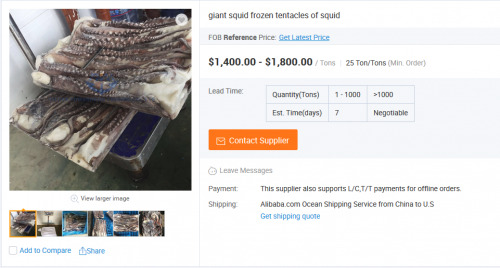
Yes, there is such a thing as too much squid.
You may find you’re not satisfied with a quote or minimum order quantity (MOQ). $1,400 per ton of giant squid tentacles may be more than you are willing to pay, or perhaps you only require 10 tons of them instead of 25. Again, ask away. Alibaba reps often have room to haggle. If you have other quotes or retail pricing to show them for comparison, go for it. Just don’t be a jerk about it. Consider what you might be able to offer them to make it worth their while.
If an MOQ is higher than you’re willing to commit to, it doesn’t hurt to see if the supplier has some flexibility there, too. Maybe they can lower it if you commit to purchasing multiple different products (giant squid eyeballs?). You might also consider committing to multiple smaller orders spaced out over the course of a year, assuming you’re confident in your volume projections. If you have a slew of questions, I recommend putting them in a numbered list to avoid important details getting lost in a big block of text.
I always request at least one sample before agreeing to purchase an item in quantity. Usually, suppliers with whom you do not have an existing relationship will expect you to pay for the sample, and that’s quite understandable. Sometimes they’ll just request that you cover the shipping. I usually ask them to send an invoice with a PayPal ID/email, but you can also pay directly via Alibaba. It’s important when requesting a sample (as with a full order quantity) to confirm what it is you’ll be receiving before committing to it. Some product pages display multiple products, or have multiple versions of a single product available with varying specs. Requesting a datasheet, manual, or any other supporting documentation is crucial.

This may require some vetting.
Once you’ve received, evaluated and approved a sample, you may be ready to commit to a full order. I won’t dive too far down the rabbit hole of payment terms, but most Alibaba suppliers will expect money up front, often via bank wire transfer (“T/T”) or PayPal, at least for your first order. Be wary of Western Union, as it offers relatively little protection against scams.
Alibaba also offers its own Alibaba Secure Payment platform. I haven’t personally used it for more than small dollar (usually sample) transactions, but it does offer a path for disputing transactions. You will also want to work out your shipping method and terms with the supplier. That is yet another topic that could be a post unto itself.
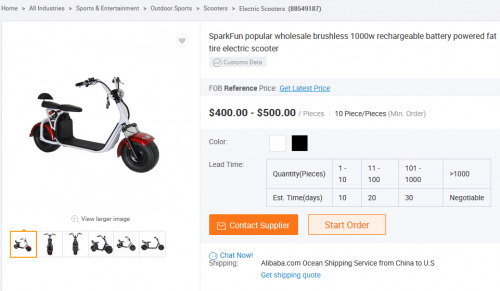
No, we don't make scooters.
A final word of caution: be wary of copyright, trademark and patent infringement. Even companies that are generally open source still aren’t exactly thrilled with companies impersonating their brand. It’s one thing to build off an existing design, but it’s another thing entirely to copy it and slap another’s logo on there. Knockoffs tend to hide quality and reliability problems behind the mask of others’ hard work and diligence. And they leave the real companies’ support personnel scrambling to field questions about products that end up having nothing to do with them. So once again, don’t be a jerk.
Moreover, should you choose to be a jerk nonetheless (or inadvertently stumble into jerkhood), customs often stops shipments of knocked off products, and you as a reseller are potentially liable for the things you choose to put on the market. Some violations are harder to spot than others. Did you know you can trademark a vague color combination? Well, neither did we!
Which leads me to another thing: educate yourself on product compliance issues (RoHS, CE, FCC, Prop 65, etc.), export restrictions, etc., or consult with someone who can get you on track in that vein. There’s a whole prairie full of rabbit holes there.
Anyway, if you want to source on Alibaba, just remember the five Ds:
1) Don’t take anything for granted 2) Documentation, documentation, documentation 3) Don’t be a jerk 4) Do do do due diligence 5) Dkeep it simple
And here is my Comprehensive List of Things Not to Buy on Alibaba:
ICs (take our word for it)
Uranium (this happened)
Human hair (because yikes)
Endangered species
Stuff that will get you sued
Things you otherwise can’t legally resell
Bulk mayonnaise (I mean why)
Doll heads (self-explanatory)

This cannot be unseen.
Be careful out there, folks. Take my timeless wisdom into consideration, trust your instincts and you will (probably?) do just fine. If you have any questions, please feel free to leave a comment and I will emerge from my meditation cave to reply as soon as the Alibaba oracle bestows her answers upon me. Happy hunting!
comments | comment feed
0 notes
Text
SparkFun Ambassadors: Class of 2019
We're very excited – today we finally announce our inaugural SparkFun Ambassadors! We’ll be honest, this took longer than expected with some late nights, a few heated discussions and probably some of the hardest decisions we’ve made. We are confident, however, that these Ambassadors are passionate about SparkFun and electronics in general, they believe in the open source movement and they enjoy connecting with others. With their help, we can celebrate more open source technology, provide better support to the engineering community, and improve our products and tutorials.
Let’s meet the four SparkFun Ambassadors!

Jesse Brockman
Jesse Brockmann is a senior software engineer with over 20 years of experience. Jesse works for a large corporation designing real-time simulation software in C and C++. He is a long-time maker, and first purchased a gyro and other components from SparkFun in 2006 to build a rover. He participated in the Sparkfun AVC from 2014 to 2017, won the heavyweight class in 2016, and won the classic AVC in 2017.

RJ Duran
RJ Duran is a multi-faceted researcher, engineer, designer, and emerging technology educator and consultant based in Denver. He co-owns and operates Laser Lab, a Denver-based laser cutting and engraving studio specializing in customization and artisan products, and teaches creative design and technology-based courses and workshops in CMCI STUDIO at CU Boulder. He is passionate about accessibility to design and fabrication technologies in education, collective creativity and developing programs, experiences, tools, and systems that enable discovery, wonder, education, inquiry and play.
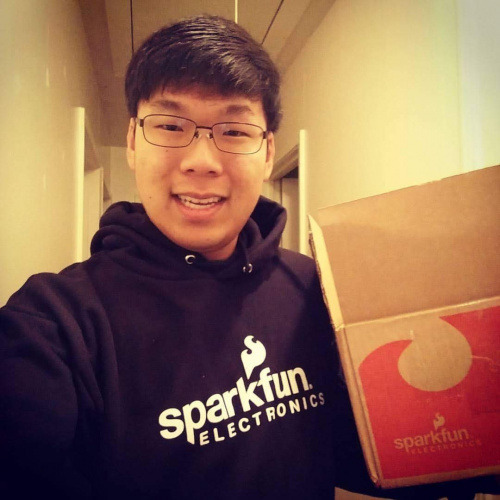
Jeremy Hong
Jeremy Hong is an electronic systems engineer living in Dayton, OH, and working in the aerospace and defense industry. He got his start as an electronics and amateur radio hobbyist, and created a consulting business, Hong's Electronics, while in high school. Today, Jeremy works all day and night designing and reverse-engineering electronics, and is very active with his local radio club, The Dayton Amateur Radio Association.

Paul Trebilcox-Ruiz
Paul is a software engineer out of Boulder, CO, and an avid maker. As a member of the 501st and Rebel Legion charity organizations, he makes screen-accurate movie props and volunteers regularly. His main costumes are a Snowtrooper, Tusken Raider and an X-Wing Pilot. Outside of movie props, Paul loves 3D printing, woodworking and creating IoT projects, including transforming a Star Wars Porg toy to translate between English and Spanish, and using augmented reality to enhance a custom board game.
Now you know our Ambassadors! We had originally planned to bring on five individuals, but due to unforeseen circumstances in the 11th hour we weren't able to fill the fifth spot. We are still planning on bringing on a fifth (and maybe sixth) Ambassador this summer, should everything go smoothly. In the next few weeks, we'll share a home page for our Ambassadors with their social media handles and any events they may be attending in the coming months. Please keep an eye out for these four – we see so much greatness in them and can't wait to see what we do together!
I am pleased to be the first to say:
WELCOME SPARKFUN AMBASSADORS OF 2019!
comments | comment feed
0 notes
Text
Properly engineered and installed selective coordination between LV circuit breakers
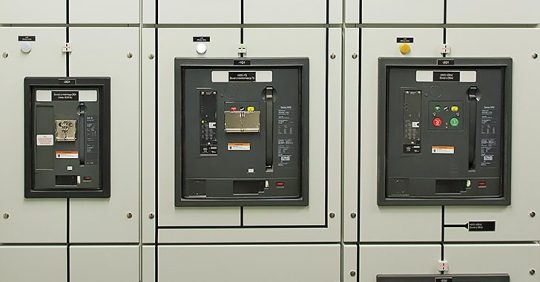
It’s extremely important to work on selective coordination of circuit breakers in the design phase of a system. After switchboards, distribution panels, MCCs, lighting switchboards, etc. are installed, there typically... Read more
The post Properly engineered and installed selective coordination between LV circuit breakers appeared first on EEP - Electrical Engineering Portal.
0 notes
Text
Minimizing failure impact in distribution systems by allowing faults to clear themselves
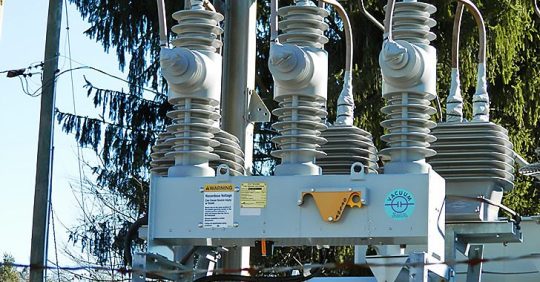
Distribution systems are basically insecure – failure of a major component always leads to customer interruptions. So, what can be done? Reliable distribution systems minimize this impact by allowing faults... Read more
The post Minimizing failure impact in distribution systems by allowing faults to clear themselves appeared first on EEP - Electrical Engineering Portal.
0 notes
Text
Friday Product Post: GPS Week 1024!
How's it going, everyone? Tomorrow is the the GPS Week Number Rollover and (unlike 1999) we are pretty prepared for it – heck, we only had 20 years to plan! In recognition of week 1024 we have a ton of new GPS and GNSS options for you, including two new GPS breakouts utilizing the M8Q package, a six-in-one GNSS Antenna Evaluation board, a stand-alone GNSS antenna and a high-power RGB LED!
As a reminder, tune in to our Youtube channel at 11 am MDT today for a Q&A livestream with the Google Engineer for TensorFlow Lite, Pete Warden, and SparkFun Founder and Engineer, Nathan Seidle, where they'll discuss all things SparkFun Edge, and will answer any questions you might have about the amazing new board! UPDATE: It's over! Watch the video here.
youtube
Which GPS option will you choose?
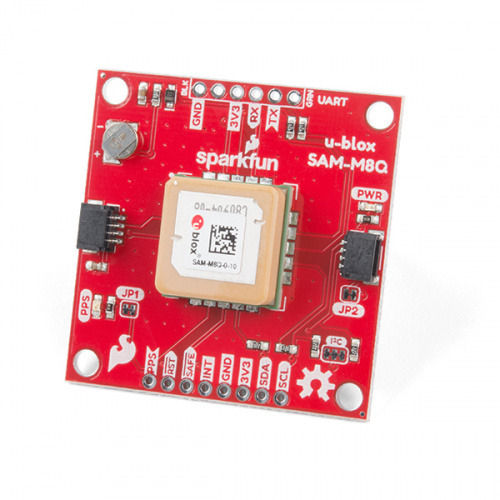
added to your cart!
SparkFun GPS Breakout - Chip Antenna, SAM-M8Q (Qwiic)
In stock GPS-15210
The SparkFun SAM-M8Q GPS Breakout is a high quality, GPS board with equally impressive configuration options.
$39.95
Favorited Favorite 2
Wish List
The SparkFun SAM-M8Q GPS Breakout is a high quality GPS board with equally impressive configuration options. The SAM-M8Q is a 72-channel GNSS receiver, meaning it can receive signals from the GPS, GLONASS, Galileo and constellations. This increases precision and decreases lock time, and thanks to the onboard rechargable battery, you'll have backup power enabling the GPS to get a hot lock within seconds! Additionally, this u-blox receiver supports I2C (u-blox calls this Display Data Channel), which made it perfect for Qwiic compatibility, so we don't have to use up our precious UART ports. Utilizing our handy Qwiic system, no soldering is required to connect it to the rest of your system. However, we still have broken out 0.1"-spaced pins in case you prefer to use a breadboard.
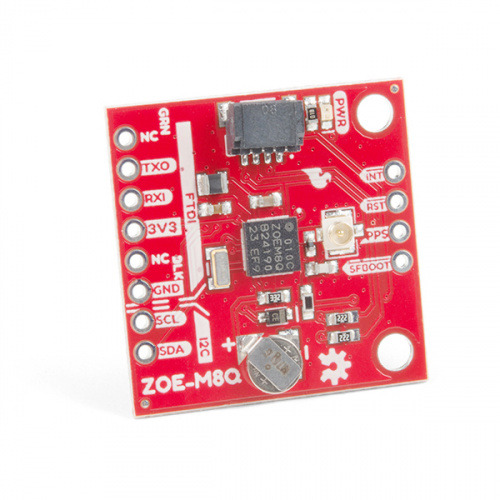
added to your cart!
SparkFun GPS Breakout - ZOE-M8Q (Qwiic)
In stock GPS-15193
The SparkFun ZOE-M8Q GPS Breakout is a high accuracy, miniaturized, GPS board that is perfect for applications that don't pos…
$44.95
Favorited Favorite 1
Wish List
Of course, if you need a GPS breakout in a smaller package, we also offer the SparkFun ZOE-M8Q GPS Breakout! This board operates in almost the exact same way as the SAM-M8Q, but since the ZOE-M8Q is a tiny GPS receiver, and in order to minimize its footprint, we've added a U.FL connector to allow the use of both large standard ceramic antennas and very small chip scale antennas.
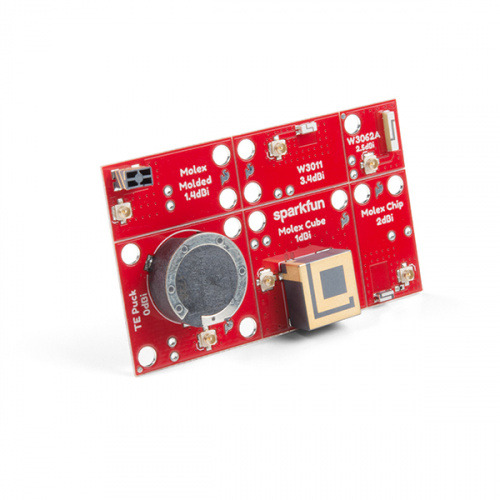
added to your cart!
SparkFun GNSS Chip Antenna Evaluation Board
In stock GPS-15247
The SparkFun GNSS Chip Antenna Evaluation Board makes it easy to test out various sized GPS antennas and geometries.
$24.95
Favorited Favorite 2
Wish List
What is the best chip antenna for your GNSS project? There are tons to choose from, but finding the right one might be tricky, so here's a board that helps make deciding easier. The SparkFun GNSS Chip Antenna Evaluation Board makes it easy to test various GPS antennas and geometries. Six different chip antennas have been populated on this board, each with a U.FL connector to attach your chip to the antenna! We've even v-scored the board so you can snap the six antennas apart and just have the one you need.
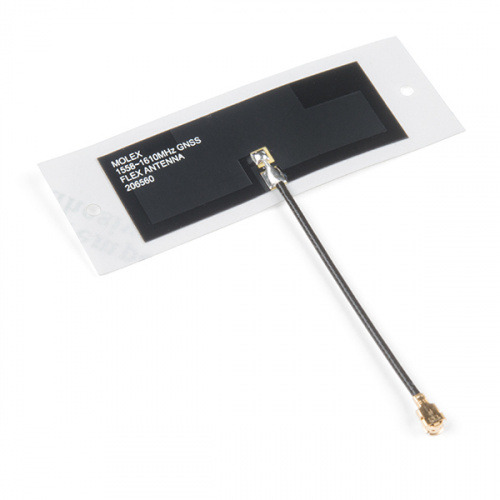
added to your cart!
Molex Flexible GNSS Antenna - U.FL (Adhesive)
In stock GPS-15246
A flexible, paper-thin GNSS Antenna with a U.FL connector and an adhesive backing.
$3.95
Favorited Favorite 3
Wish List
The Molex GNSS Flex antenna is paper-thin, makes a great option for basic GNSS applications, and will work with any of our GNSS boards equipped with a U.FL at a fraction of the cost of many of its big brothers. This antenna supports GPS, Galileo, BeiDou and GLONASS in three different frequency bands (1561 +/-3MHz, 1575 +/-3MHz, 1602 +/-3MHz).
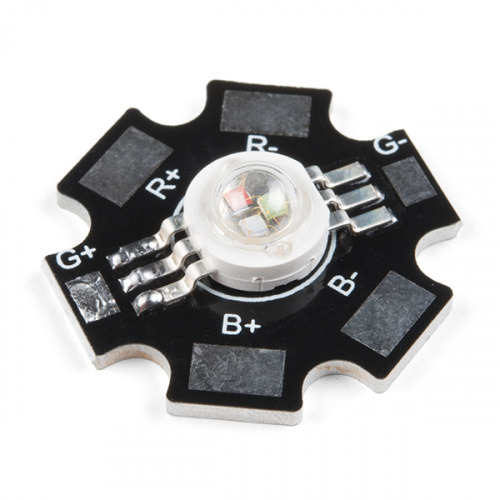
added to your cart!
Triple Output High Power RGB LED
In stock COM-15200
This 3W per channel, Triple Output High Power RGB LED is sure to shed a lot of light on any project you add it to.
$4.95
Favorited Favorite 0
Wish List
So much power and light from such a small package. This 3W-per-channel, Triple Output High Power RGB LED is sure to shed a lot of light on any project. This LED acts as any other, except it requires much more power while delivering a light that is incredibly intense.
That's it for this week! Make sure to join us next week as we celebrate the start of a certain famous fantasy show's final season! As always, we can't wait to see what you make! Shoot us a tweet @sparkfun, or let us know on Instagram or Facebook. We’d love to see what projects you’ve made!
comments | comment feed
0 notes
Text
Enginursday: The Qwiic Jukebox
Over the past couple months, I have been working with my three-year-old son to create his own jukebox.
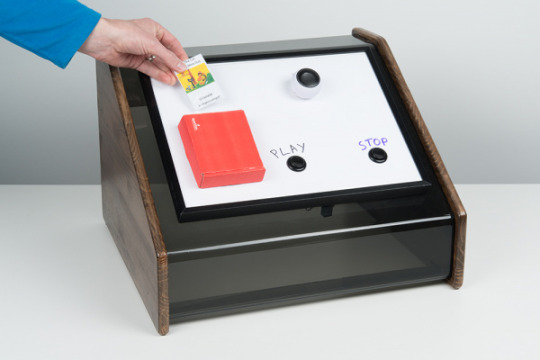
He wanted it to play some recordings we made of us reading books together.
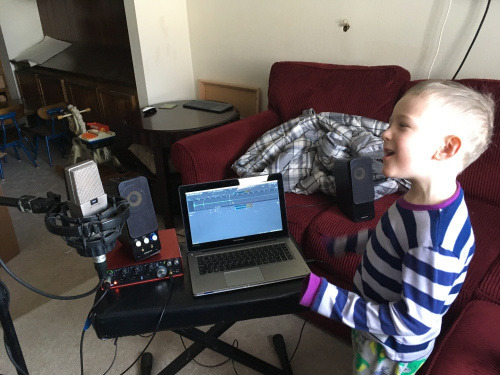
It uses RFID tags as the selection process, and is totally Qwiic-based.

We have worked out most of the bugs. It is truly amazing how good a three-year-old is at beta testing. We ended up making a detailed hookup guide and video, so if you'd like to make one yourself, please check those out and share in the comments. Enjoy!
youtube
Qwiic Jukebox Tutorial
comments | comment feed
0 notes
Text
Microcontroller Power Consumption
All this talk about how “mind bendingly low” the power consumption is on Ambiq Micro's Apollo3 Blue microcontroller used on The SparkFun Edge reminded us to reflect back on some data gathering we did previously on some other of our very popular boards: the Arduino Pro Mini 5V and Arduino Pro Mini 3.3V. In fact, we just released some new starter kits for these boards a few weeks ago!
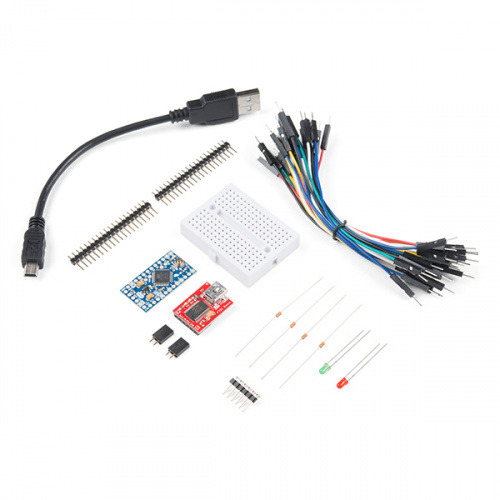
added to your cart!
SparkFun Arduino Pro Mini Starter Kit - 5V/16MHz
In stock KIT-15254
What's blue, thin, and comes with everything you need to get started? The Pro Mini 5V Starter Kit!
$29.95
Favorited Favorite 0
Wish List
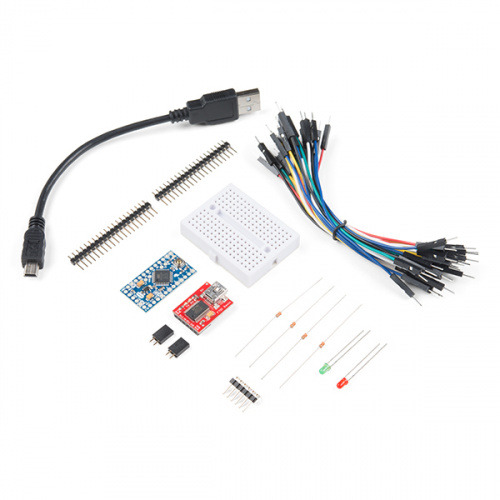
added to your cart!
SparkFun Arduino Pro Mini Starter Kit - 3.3V/8MHz
In stock KIT-15257
What's blue, thin, and comes with everything you need to get started? The Pro Mini 3.3V Starter Kit!
$29.95
Favorited Favorite 1
Wish List
While the tutorial linked below was written back in 2016, the release of these starter kits shows how applicable it is today, especially if you're just getting started or aren't yet ready for the SparkFun Edge. If you are working with something like the SparkFun RedBoard, Arduino Pro Mini or any other kind of microcontroller, check out our tips for reducing Arduino power consumption, and see which ideas can be applied to your project to decrease the power consumption and increase the battery life!
Reducing Arduino Power Consumption
November 10, 2016
A tutorial about different ways to reduce the current draw for your next Arduino project the easy way.
Favorited Favorite 11
As a reminder, The SparkFun Edge board currently measures ~1.6mA at 3V, and 48MHz and can run solely on a CR2032 coin cell battery for up to 10 days. For comparison, in our Reducing Arduino Power Consumption tutorial, we used an ATmega328 with Arduino Optiboot (Uno) on a breadboard to eliminate all the power hungry components. Spoiler alert: even with that bare-bones approach, the microcontroller pulled between 13.92-3.87 mA, depending on Vcc and clock speed.
Do you have additional ideas to reduce power consumption? Check out others' tips and share your ideas on SparkFun's forums at the power management page.
SparkFun Forums: Power Management
comments | comment feed
0 notes